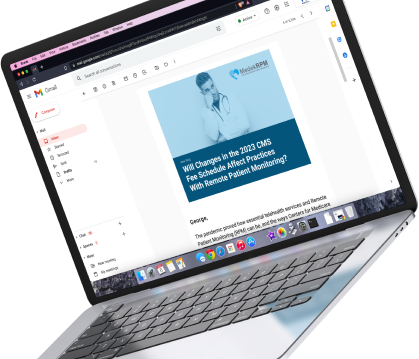
For people dealing with chronic health issues, remote patient monitoring (RPM) has emerged as a powerful solution. Chronic conditions may include common ailments such as hypertension, diabetes, COPD, and congestive heart failure. Medical research has proven that remote patient monitoring leads to decreased emergency department visits, prevention of hospital readmissions, and shorter hospital stays. One study has proven a 73% reduction in hospital readmissions1. This is valuable news to patients and providers dealing with chronic conditions.
Chronic diseases are the leading cause of death and disability nationwide. They are also one of the most costly, with over $4 Trillion2 in expenditures being allocated for chronic care management. Statistically, in the United States, four in ten adults have two or more chronic conditions. Medical experts expect these conditions and costs to rise. With RPM, clinicians can significantly reduce healthcare costs while improving health outcomes for chronic care patients.
Here are some of the benefits of RPM for your chronic care patients:
1. Preventing Minor Issues from Becoming Major Crises
RPM allows patients to remain in their homes while a provided medical device takes daily health readings and sends them to healthcare professionals, including the patient’s primary care physician. These readings are in real-time, and a physician can immediately address any suspect reading. This prevents minor issues from escalating into major crises.
This early identification of a health issue is one of the major benefits of RPM. Many patients will only make doctor appointments if their health becomes problematic. Patients with chronic conditions may see their doctor for two, three, or four scheduled appointments yearly. This gives the doctor only four or fewer health readings, or data points, a year to change a chronic care health program. With RPM, physicians will have 365 readings (data points) annually to adapt to prescriptions, regimens, or lifestyle habits.
Additionally, certain behaviors can now be linked to changes in the chronic condition. The old joke that having your mother-in-law visit will cause your blood pressure to rise can now be documented (if it is true). Have the holidays raised your blood sugar? With RPM, you and your doctor will know for sure. You don’t want to wait until a change in a patient’s diet has caused heart failure before anyone knows there is a problem. Early intervention is a major benefit of RPM.
2. Treatment Plans Can be Adapted and Changed
This leads to another benefit for RPM, the ability to make timely adjustments to treatment plans. With an RPM portal3, physicians can check how their patients are doing. As a result, they can see how their patients respond to medications and adjust prescriptions when necessary.
Without remote patient monitoring for chronic disease management, many patients go months with an ineffective or unoptimized treatment plan. Remote patient monitoring can help patients find a treatment plan that works for them while reducing chronic disease progression. Likewise, RPM can also show improvements in conditions.
Though it is expected that a chronic condition does not improve, that is not always the case. Lifestyle changes, changes in diet, and effective medication can alter what was considered an ever-worsening health condition. Another benefit of RPM is proving that a health plan is effective and working.
3. Greater Patient Engagement and Retention
Patients often know that certain behaviors can make their chronic conditions worse but will still participate in these unhealthy actions. RPM involves patients in their own healthcare. This greater level of engagement helps them to see cause-and-effect results of their choices. Greater ownership of their health often equates to more positive and consistent behaviors.
Many physicians struggle to keep their patients engaged with a prescribed health plan. Patients may know the plan, have the medications, obtain a diet plan, and promise to make lifestyle changes. Unfortunately, this is often insufficient to keep patients engaged and consistent in their behavior. Another benefit of RPM is greater engagement.
Furthermore, for the medical practice, the retention of patients is a benefit over the costs of acquiring new patients. Greater engagement often leads to greater loyalty. RPM is about expanding healthcare outside the conventional hospital setting and into the patient’s daily lifestyle. Patients appreciate this change and will remain with a practice that provides them with this option.
4. Consistent Reimbursements
Due to recent changes with CMS4, remote patient monitoring has more CPT© Codes5 that can provide more and consistent reimbursements from Medicare and Medicaid. While not all chronic care patients are on either of these two government programs, most people with heart disease, diabetes, hypertension, kidney failure, COPD and recovery from stroke are often over 65 years old.
RPM permits for consistent monthly billing for the consistent care provided. While an individual visit to a doctor’s office may have a greater reimbursement, the constant and consistent reimbursement of 12 months of remote patient monitoring provides greater revenue that can be used for planning and budgetary needs. RPM often has lower expenses than an in-office visit, or several visits. RPM also gives a physician more available time than a couple of office visits.
RPM can provide your chronic care patients with early intervention, greater proof of effective medical treatments, enhanced engagement, and better health outcomes. Furthermore, it can provide your medical practice with consistent reimbursements, greater revenue, and more available time for your physicians.
If your practice treats patients with chronic conditions, as most due, then you owe it to your practice to learn how these RPM features can be benefits for you, your practice and your patients.
Medek RPM is one of the fastest-growing RPM Providers in the U.S. Connect with our of Medek Representatives to start a conversation today.
Footnotes:
- https://www.ncbi.nlm.nih.gov/pmc/articles/PMC3771544/
- https://www.cdc.gov/chronicdisease/programs-impact/pop/index.htm#:~:text=Chronic%20diseases%20are%20the%20leading,interventions%20can%20be%20cost%2Deffective.
- https://www.medekrpm.com/
- https://www.cms.gov/
- https://www.ama-assn.org/practice-management/cpt/cpt-overview-and-code-approval





